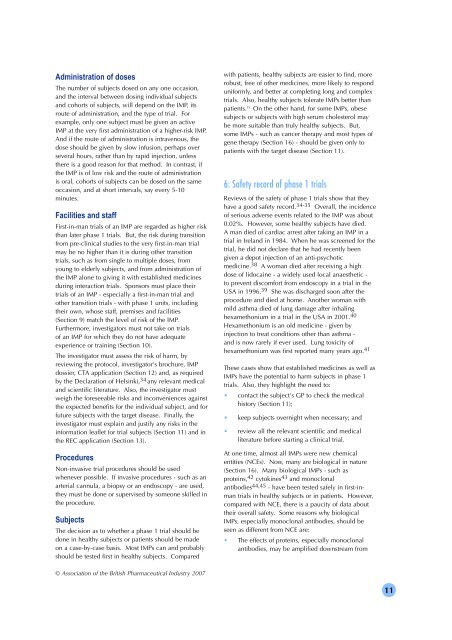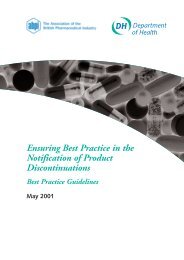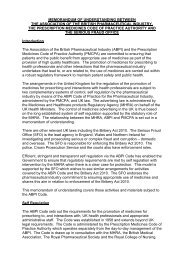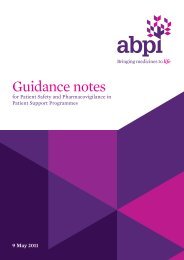ABPI Guidelines for Phase 1 Clinical Trials (PDF
ABPI Guidelines for Phase 1 Clinical Trials (PDF
ABPI Guidelines for Phase 1 Clinical Trials (PDF
Create successful ePaper yourself
Turn your PDF publications into a flip-book with our unique Google optimized e-Paper software.
Administration of doses<br />
The number of subjects dosed on any one occasion,<br />
and the interval between dosing individual subjects<br />
and cohorts of subjects, will depend on the IMP, its<br />
route of administration, and the type of trial. For<br />
example, only one subject must be given an active<br />
IMP at the very first administration of a higher-risk IMP.<br />
And if the route of administration is intravenous, the<br />
dose should be given by slow infusion, perhaps over<br />
several hours, rather than by rapid injection, unless<br />
there is a good reason <strong>for</strong> that method. In contrast, if<br />
the IMP is of low risk and the route of administration<br />
is oral, cohorts of subjects can be dosed on the same<br />
occasion, and at short intervals, say every 5-10<br />
minutes.<br />
Facilities and staff<br />
First-in-man trials of an IMP are regarded as higher risk<br />
than later phase 1 trials. But, the risk during transition<br />
from pre-clinical studies to the very first-in-man trial<br />
may be no higher than it is during other transition<br />
trials, such as from single to multiple doses, from<br />
young to elderly subjects, and from administration of<br />
the IMP alone to giving it with established medicines<br />
during interaction trials. Sponsors must place their<br />
trials of an IMP - especially a first-in-man trial and<br />
other transition trials - with phase 1 units, including<br />
their own, whose staff, premises and facilities<br />
(Section 9) match the level of risk of the IMP.<br />
Furthermore, investigators must not take on trials<br />
of an IMP <strong>for</strong> which they do not have adequate<br />
experience or training (Section 10).<br />
The investigator must assess the risk of harm, by<br />
reviewing the protocol, investigator's brochure, IMP<br />
dossier, CTA application (Section 12) and, as required<br />
by the Declaration of Helsinki, 34 any relevant medical<br />
and scientific literature. Also, the investigator must<br />
weigh the <strong>for</strong>eseeable risks and inconveniences against<br />
the expected benefits <strong>for</strong> the individual subject, and <strong>for</strong><br />
future subjects with the target disease. Finally, the<br />
investigator must explain and justify any risks in the<br />
in<strong>for</strong>mation leaflet <strong>for</strong> trial subjects (Section 11) and in<br />
the REC application (Section 13).<br />
Procedures<br />
Non-invasive trial procedures should be used<br />
whenever possible. If invasive procedures - such as an<br />
arterial cannula, a biopsy or an endoscopy - are used,<br />
they must be done or supervised by someone skilled in<br />
the procedure.<br />
Subjects<br />
The decision as to whether a phase 1 trial should be<br />
done in healthy subjects or patients should be made<br />
on a case-by-case basis. Most IMPs can and probably<br />
should be tested first in healthy subjects. Compared<br />
© Association of the British Pharmaceutical Industry 2007<br />
with patients, healthy subjects are easier to find, more<br />
robust, free of other medicines, more likely to respond<br />
uni<strong>for</strong>mly, and better at completing long and complex<br />
trials. Also, healthy subjects tolerate IMPs better than<br />
patients. 35 On the other hand, <strong>for</strong> some IMPs, obese<br />
subjects or subjects with high serum cholesterol may<br />
be more suitable than truly healthy subjects. But,<br />
some IMPs - such as cancer therapy and most types of<br />
gene therapy (Section 16) - should be given only to<br />
patients with the target disease (Section 11).<br />
6: Safety record of phase 1 trials<br />
Reviews of the safety of phase 1 trials show that they<br />
have a good safety record. 34-35 Overall, the incidence<br />
of serious adverse events related to the IMP was about<br />
0.02%. However, some healthy subjects have died.<br />
A man died of cardiac arrest after taking an IMP in a<br />
trial in Ireland in 1984. When he was screened <strong>for</strong> the<br />
trial, he did not declare that he had recently been<br />
given a depot injection of an anti-psychotic<br />
medicine. 38 A woman died after receiving a high<br />
dose of lidocaine - a widely used local anaesthetic -<br />
to prevent discom<strong>for</strong>t from endoscopy in a trial in the<br />
USA in 1996. 39 She was discharged soon after the<br />
procedure and died at home. Another woman with<br />
mild asthma died of lung damage after inhaling<br />
hexamethonium in a trial in the USA in 2001. 40<br />
Hexamethonium is an old medicine - given by<br />
injection to treat conditions other than asthma -<br />
and is now rarely if ever used. Lung toxicity of<br />
hexamethonium was first reported many years ago. 41<br />
These cases show that established medicines as well as<br />
IMPs have the potential to harm subjects in phase 1<br />
trials. Also, they highlight the need to:<br />
• contact the subject's GP to check the medical<br />
history (Section 11);<br />
• keep subjects overnight when necessary; and<br />
• review all the relevant scientific and medical<br />
literature be<strong>for</strong>e starting a clinical trial.<br />
At one time, almost all IMPs were new chemical<br />
entities (NCEs). Now, many are biological in nature<br />
(Section 16). Many biological IMPs - such as<br />
proteins, 42 cytokines 43 and monoclonal<br />
antibodies 44,45 - have been tested safely in first-inman<br />
trials in healthy subjects or in patients. However,<br />
compared with NCE, there is a paucity of data about<br />
their overall safety. Some reasons why biological<br />
IMPs, especially monoclonal antibodies, should be<br />
seen as different from NCE are:<br />
• The effects of proteins, especially monoclonal<br />
antibodies, may be amplified downstream from<br />
11









